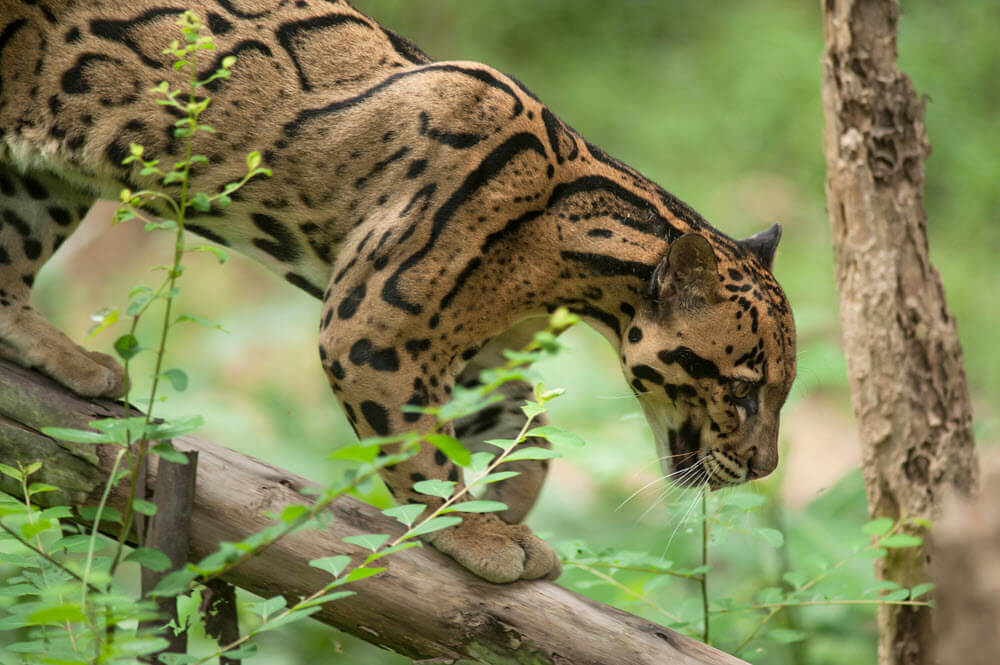The clouded leopard, along with the Sunda clouded leopard, are the smallest big cats.
Even though they are called “leopards” they are not directly related to regular leopards. it is believed that there are fewer than 10,000 adult clouded leopard cats still living in the wild, with a declining population.
The cat can be found throughout the Himalaya foothills, in addition to southern China and Taiwan all the way to the Malaya Peninsula.
Scientific Name: Neofelis nebulosa
Conservation Status: Vulnerable, declining population
Subspecies: None
 Meaning of the name
Meaning of the name
“Clouded” refers to how the spots look on the cat’s fur. Leopard is a compound word meaning “lion” and “panther.”
Some clouded leopard facts
- Relative to the size of its body, the longest teeth of all the wild cats.
- Considered the best climber of all the big and small cats, even though they usually hunt on the ground.
- Using their paws and sharp claws, they can hang upside down.
- The clouded leopard is the state animal of Meghalaya, India. The name Meghalaya means “the abode of clouds” in Sanskrit.
Physical appearance
The clouded leopard is a short, sturdy cat that weighs between 25 and 51 lbs. Their body length is between 27 and 30 inches, with a tail that is an additional 24 to 32 inches in length. Males are larger than females. The cat’s fur can range in color from a pale yellow to grey or brown. Large cloud-looking spots cover the cat’s body, with smaller spots on the cat’s head and tail. Dark bands run from the corner of the cat’s eyes to its cheeks, and down around its neck and shoulders. The cat is known for their extremely long teeth. Compared to the size of its body, the clouded leopard’s teeth are longest of all the big cats. They also have very big paws.
Clouded leopards communicate with sounds such as hissing, growling, moaning, snorting and mewing.
Where clouded leopards live
 Populations of clouded leopards can be found in India, Nepal, Bhutan, India, Bangladesh, Myanmar, Thailand, Peninsular Malaysia, Indochina and in China south of the Yangtze River. The cat is rarely seen in the wild.
Populations of clouded leopards can be found in India, Nepal, Bhutan, India, Bangladesh, Myanmar, Thailand, Peninsular Malaysia, Indochina and in China south of the Yangtze River. The cat is rarely seen in the wild.
Hunting and food
Clouded leopards are adept climbers and can even hang down from branches using only their tail and back paws for support. They can also climb on branches horizontally with the back to the ground. The leopards prey on porcupine, primates, pigs, cattle, goats, squirrel, deer, anteaters and pheasants.
Reproduction and lifespan
The leopards will begin mating at around two years of age. A male will mate with the female several times over a period of days and then leave the female to raise the kittens on her own. Litters usually average three kittens with a range of 1 to 5. The spots on a newborn cub are completely solid. It is believed the kittens separate from their mother at around 10 months of age. Males will develop faster than females. Captive clouded leopards have lived as long as 17 years.
Clouded leopard conservation issues
Loss of habitat from deforestation is one of the main conservation issues for the leopard, along with poaching and wildlife trade. Although the clouded leopard is legally protected in many regions, there is poor enforcement of hunting bans. It takes 25 clouded leopards to make one clouded leopard fur coat. The Rukai, one of Taiwan’s aboriginal people, honor the clouded leopard and consider hunting the cat taboo.


me like wild cats :]